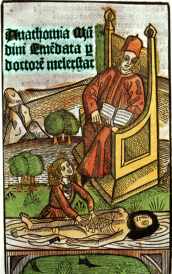Too bad the opposition to the knowledge on how to prevent crime, alcoholism, lung cancer,
| Example Three - Rabies |

STATISTICS SAY WHO
Gets Conditions,
Don't Wait Centuries To Act on Them
| Links to Answers At Bottom |
1. Learn WHO (generally speaking herein, let's say 90% of the time) has it, who does it. 2. Learn what is different about them. They are getting/doing something different; find out what is different that they are doing, ingesting, receiving, etc. 3. Study the identifiable population group (not just a limited segment or even citing one's own personal case!). It is that professional analysis process gives the professional the answer. (Whether the layman understands, is quite another point; witness the lay inability to grasp professional mathematical data showing that the planet earth is round, a globe, a moving globe -- all concepts contrary to the lay "common sense" that the planet earth is flat and motionless. Click here for background on this.)
| "the reign of [English King] Henry II (1154-1189)," says Bentley College Mathematics Professor Amir D. Aczel, Ph.D., Statistics: Concepts and Applications (Chicago: Richard D. Irwin, Inc., Pub., 1995), p 245.
Analytically, "the general concept underlying the [statistical analysis] procedure was understood by the Britons of the 12th century!" (p 248). |
"bade foster mothers to suckle . . . children, to bathe and wash them but in no way to prattle with them or speak to them, for he wanted to learn whether they would speak the Hebrew language, which was the oldest, or Greek or Latin, or Arabic, or perhaps the language of their parents of whom they had been born. But he labored in vain, because all the children died. For they could not live without the petting and joyful faces and loving words of their foster mothers."In modern terms, we call that the 'failure-to-thrive syndrome.' What we can learn from this 13th century experiment, is that
| Example One - Scurvy |
Here is an example. Dr. J. G. H. Kramer in 1734 observed a scurvy-fruit/vegetables link (correlation). Soldiers who ate fruit and vegetables generally did not get scurvy; those who did not, generally speaking, got it. Problems: the data was not a 100% correlation; there was 0% data on why. Just data on WHO.
Dr. James Lind in 1747 observed that data, and studied into a similar 1537 correlation analysis, and further observed that statistics showed a scurvy-fruit juice link. Sailors who drank fruit juice (from oranges, lemons, or limes) did not get scurvy. Those who did not, generally speaking, got it. Problem: the same as 1734, no 100% correlation, and 0% data on why. Just data on WHO.
Objection, yell the laymen and media!! Fruits are different than fruit juices! And they are both different than vegetables!! There are lots of other variables and correlations. You doctors, you are incompetent! or liars!!
Indeed, neither the doctor in 1537 nor Dr. Kramer nor Dr. Lind in the 1730's and 1740's knew WHY the correlations/statistics showing a scurvy-fruit and vegetables or fruit-juice link were true. Vitamins such as vitamin C would not be discovered for many centuries. During all those four centuries, all the advocates of fruit and vegetables had as evidence—was correlation statistics! And to laymen, those were b___ s___ !
As Drs. Kramer and Lind had nothing—repeat, nothing, to prove their link claim but correlations/statistics (WHO generally gets the scurvy, not, WHY they get it), the public and thus the government refused to act on those statistics (pure science) for almost fifty more years. They were not 100% you see!!
And much worse to laymen, the idea of going by such statistics violated peoples' rights. It did not sit well with laymen, i.e., it was not politically acceptable to issue fruits and vegetables to common soldiers and sailors. Those were for officers, only. They had a right (had earned it!) to better food!! Officers get the fruits and vegetables, not the common soldiers and sailors! How dare mere doctors object to the established ways of society!! propose violating officers' rights!!
| Example Two - Smallpox |
| Example Three - Rabies |

| The statistics then were, rabies was 100% fatal.
Doctors' job is to create new methods/treatments that OVERRULE such facts.
We don't go to a doctor simply to be told the OLD statistics (you'll die, 100% for sure!!)
We go to the doctor, create a new reality, develop new statistics of cure, new statistics that don't even exist yet, even if the doctor doesn't know the why. |
| Example Four - Streptococcus Infection |
| Example Five - Dose-Response Statistics |
Another aspect of statistics is "dose-response" correlation. A "dose-response" correlation supports causation. Here is a classic example. Robert Hooke (1653-1703) did a statistical analysis of weights and spring lengths. Re weights at the end of a spring, he recorded the resulting statistics: More weight, longer spring; less weight, shorter spring. The weight was the independent variable. Conclusion: Varied weight causes spring length to change, i.e., a "dose-response" correlation (an aspect of statistics) supports causation. This dose-response correlation constitutes a strong disproof of uneducated people's anti-statistics notions.
| Example Six - Mendel's Genetic Analyses |
![]()
| "The work of Gregor Mendel seems even more remarkable when you consider that he made his brilliant observations, drew valid conclusions, and formulated hypotheses without any knowledge of genetic materials. It was twenty years after the [1865] publication of his paper [before] the cell nucleus was recognized as the center of hereditary materials.
"Mendel knew nothing of the [action process] of chromosomes during meiosis. In fact, he had never heard of a chromosome. Yet he formulated the [correct analysis] of [the process] on the [sole] basis of what he observed . . . . Mendel described what happened [statistically] in various genetic crosses without having any idea of the biological mechanisms by which they occurred."—Otto and Towle, Modern Biology, supra, p 149. |
| Example Seven - Hutton's Heat vs. Water Effects Analysis |
| Example Eight - Cholera Prevention: The Classic Broad Street Pump Case |
circulation of the blood statistics by Dr. William Harvey: re "valves in the veins-little gates that fasten tight to keep blood from flowing through [backwards] . . . all [100%] of those valves point toward the heart [to] keep blood flowing away from the heart," p 21. With such statistics, he was enabled to go on to show "that the blood moves in a circle through the body; that the veins take back to the heart the same blood that it previously pumped out," p 22. statistics on chest sounds by Dr. Leopold Auenbrugger, enabling him to devise the percussive process whereby physicians can "distinguish between a healthy chest and one that was diseased," p 28. Auenbrugger had started with statistics on casks, noting different sounds produced dpending on the liquid/air ratio of the contents therein, enabling expertise "in locating the exact spot in a cask where the [contents] ended and air began," p 27. statistics on sound traveling through wood, enabling Dr. Rene Laennec to devise the stethoscope to enable to "distinguish between diseases that, through [another method], gave the same sound, p 32. statistics on the digestion process in the stomach, enabling Dr. William Beaumont to determine "the rate of digestion of various foods . . . the motion of the stomach during digestion . . . the character of the digestive juices . . . the influence on the stomach of worry and excitement, and also the injurious effects of large quantities of tea, coffee and alcohol . . . how the stomach operates, and what interferes with its operation . . . which foods are digested quickly and which take a long time, which are digested in the stomach itself, and which are sent on to be digested in the intestines," pp 37-38. statistics on light and shadow by Dr. Hermann von Helmholtz to devise the opthalmoscope "to see inside the human eye [to show] that the pupil really is a transparent window, and that light directed through it is reflected from the retina," p 42.
The former denounce statistics, correlations, "pure science," about differences and tirade that factors in common should be used and focused on, not variables, differences. Such bunkum sounds good to the uneducated and unalert. Educated people generally know better.
"Early writings, some of them believed to date back at least 2,500 years [B.C.E.], give ample evidence on [physicians' sound analysis methods and skill. A doctor] was a well-trained, skillful and sophisticated practitioner, capable of delicate operations. A cataract operation, which restored sight by delicately moving an opaque lens within the eye, was routine in 1000 B.C. in India."Early [doctors] also repaired hernias, delivered babies by Caesarian section and performed such complex skin-grafting operations as rhinoplasty—the reconstruction of the nose by taking skin from the cheek. . . . The Greeks and Romans were also skilled in surgery. But with the disintegration of the Roman Empire . . . the Dark Ages encompassed Europe." For reasons like the reaction to the correlation data on scurvy, genuine knowledge was suppressed.
 But even then Dr. Guy de Chauliac (c. 1300-1368) [physician to Pope Clement VI] . . . practiced serious surgery . . . removal of cancerous growths [and did] operations on hernias and cataracts."
But even then Dr. Guy de Chauliac (c. 1300-1368) [physician to Pope Clement VI] . . . practiced serious surgery . . . removal of cancerous growths [and did] operations on hernias and cataracts."
And Dr. "de Chauliac's [1363] treatise on surgery . . . served as a definitive text for hundreds of years."—Russel V. Lee, Sarel Eimerl and the Editors of LIFE, The Physician, Life Science Library Series (New York: Time Inc, 1967), pp 24, 32.



"Surgeons [in the Roman era had] devised ingenious forceps and tweezers and other instruments for special operations. They extracted goiters, tonsils, and stones, apparently with considerable success. In the Caesarean operation (said to have been performed first at the birth of Julius Caesar [100 BC]) they developed a method for delivering babies who could not be born in the normal way."Surgeons were regularly attached to the Roman legions, and hospitals first appeared as establishments for the treatment of sick and wounded Roman soldiers. The cities then set up hospitals for civilians. These hospitals were the first public institutions of the sort in the history of Europe."—Crane Brinton, John B. Christopher, and Robert Lee Wolff, A History of Civilization: Volume I: Prehistory to 1715 (Englewood Cliffs, NJ: Prentice-Hall, Inc, 1955), p 113.
"Galen of Pergamum (c. 129-99 [B.C.E.] perhaps the last great doctor of antiquity to engage in dissection, wrote voluminously; some of his many essays remained standard medical handbooks to A.D. 1800," says Prof. Chester G. Starr, A History of the Ancient World, 3rd ed (Oxford Univ Press, 1983), p 594.
An "Arab medical text called the Royal Book, written in the tenth century by Ali Ibn al-Abbas, physician to the Caliph in Baghdad . . . contained twenty chapters on subjects including urinalysis, dietetics, gynæcology, surgery and the capillary system. . . . By the 12th century the [Medical] School at Salerno [Italy] was able to use this type of diagnosis to identify no less than nineteen different diseases. . . . The medical course consisted of three years' general study . . . four more on medicine, with a final eighth year . . . as an intern."—James Burke, Connections (Boston: Little, Brown and Co, 1978), p 125.
'are there are any medical studies on WHO does the crime? Maybe not 100%, but knowing, perhaps enough to do a 90% reduction in crime would help!!'
|
Did you hear the anecdote about the layman—a media writer or politician, I forget—who denounced statistics, pure science type correlations?
He/she never took a statistics class, but knew all about them—a legend in his own mind. 'A sample is not enough,' he said. 'A factor has to be 100% or it's not true.' 'You have to know the why, doc.' 'Nothing less is good enough for me.' 'Everybody who uses statistics without 100% correlation, causation, and knowing the why, they are all wrong.' Luckily for society lest we suffer from more writings, laws, or decisions by this paranoid delusional (delusions of grandeur) writer/official, his psychiatrist cured him. How? you ask. The next blood test that SOB needed, well, less than a 100% sample wouldn't be good enough for him/her, so 'take it all, nurse—take 100%.' :-) That dullard, but that dullard ONLY, got the point. :) |
| In addition, notice that others in the media—despite the existence of voluminous data on the subjects herein cited, being published for ± a century, offer up a different malicious lie—the claim that 'nobody knows' the causation process _______.
When you read such a media writer or official claim that 'nobody knows' _______, recognize that the writer is
(The legal basis for hanging such a publisher, writer, or official for his/her writing or words, is that said words aid and abet, are accessory to, deaths—just as surely as, e.g., a 'stick-up note' aids and abets / is accessory to, e.g., a bank robbery.) |
'Hey people, _________ is the 90% factor in crime. Let's issue an order, get rid of it. And so prevent crime from occurring in the first place.'The people named above did that, said this concept. Tell me, what do you think the public response was?
*Action on the 90% factor (______) including having orders issued dealing with it (like the orders on issuing limes)?or
*Telling doctors to sit down and shut up; they're offending too many people, they're advocating violating people's rights by advocating eliminating ______.
| Another scam goes along these lines. Cause A causes Effects B, C, D, and E. The scam artist picks out one item among the B, C, D, and E, and pretends that THAT is the cause. Example: Pretending that C causes B, D, and E.
On auto crashes, the public would not be scammed. We know that drunk driving causes car crashes, that car crashes cause broken arms, broken legs, lacerations, closed-head injuries, etc. We would not be scammed into thinking that, e.g., broken legs cause broken arms! The scam works only on matters on which the public is not educated. Here is another way the pro-tobacco scam functions to undermine a truth. For example, you say "tobacco causes effect 'A'." The scammer / hater immediately rants, "you've just said, tobacco ALWAYS causes effect 'A.'" Or, "you've just said, tobacco is the SOLE CAUSE of effect 'A.' No, you merely said, "tobacco causes effect 'A'." Had you said, "drunk driving causes car crashes," or "car crashes cause broken bones," nobody would have ranted, "you said, drunk driving ALWAYS causes car crashes," or "you said, car crashes ALWAYS cause broken bones." Or ranted, "you've just said, drunk driving is the SOLE CAUSE of car crashes," or, "you've just said, car crashes are the SOLE CAUSE of broken bones." No, on such matters, the scammers / hater recognize the grammar of sentence structure and know that their lying scam won't work in THAT case. But on tobacco, on which the public is un / under-educated due to the "tobacco taboo," censorship, the scam / hateranting can indeed deceive the un/under-educated. This website helps you recognize pusher hate / scams, by educating you on (a) statistics, and (b) pusher / hater scams, e.g., their twisting, distorting, misrepresenting, what is said. |
| For background on the dumbing down of America such that even numbers of "educated" people (not the mention the poorly educated) cannot comprehend statistical and similar data, see, e.g.,
Manuel Valenzuela, "The Dumbing Down of America" (2 January 2007), who cites "the dumbing down of America, the methodical destruction and purposeful elimination of the means by which a society educates and enlightens itself." Note that the U.S. "educational system was twisted into a test taking industry that is careful, above all, not to teach children how to think," says Prof. David Michael Green, in "One day you’re gonna wake up, America" (4 May 2007) (Green is Professor of Political Science at Hofstra University, New York). Note "the huge gap between funding for military ventures and US public education," says Emily Spence, "We Can't Get No Educashion: A Critique Of US Public Schools" (26 August 2007). A lament of America's dumbing down is given by Chris Hedges, M.Th., in "America the Illiterate" (November 2008), citing loss of emphasis on reading and in-depth thought, and instead mere images and superficiality. America being dumbed down has causes, see details by, e.g., Susan Jacoby, The Age of American Unreason: Dumbing Down and the Future of Democracy (London: Old Street Publishing, 2008), and George Monbiot, "Why Morons Succeed in US Politics" (The Guardian, 28 October 2008). See also Prof. Richard Hofstadter, Anti-Intellectualism in American Life (1963). Paul Craig Roberts, Ph.D., "Polls Show Many Americans are Simply Dumber Than Bush" (29 January 2006), who says that "Half of the US population is incapable of acquiring, processing and understanding information. . . . half of the American population is unable to draw a rational conclusion from unambiguous facts. . . . the inability of half of the US population to acquire and understand information are far larger threats to Americans than terrorism." For more on this subject, see our 1914 Edison Memo Background Site. |
| A "false correlation that [a lurking variable] causes is called spurious correlation."
And "the third variable, which . . . is actually causing the observed correlation between [other factors] is referred to as a lurking variable." What is the result? "Two characteristics may appear to be strongly related." Why? "due to the common influence of a third factor [the "lurking variable"] not included in the study. In such cases the dependence is called a spurious dependence. “For instance, if a sample of individuals is classified [as] to whether or not they are heavy drinkers and [have] respiratory trouble, we would probably find a high [correlation] and conclude that a strong statistical association existings between drinking habit and lung condition. “But the reason for the [statistical] association may be that most heavy drinkers are also heavy smokers and [that] is a direct cause of respiratory trouble.”—Richard A. Johnson and Gouri K. Bhattacharyya (Univ of Wisconsin, Madison), Statistics: Principles and Methods, 3rd ed. (John Wiley and Sons, Inc, 1987, 1992, 1996), pp 103 and 558. For example, in dealing with “all the [people] who share many characteristics [the statistical method includes to] pinpoint the single characteristic they don't share. This is how [to] isolate the true impact. . . . This is how the impact of that [factor]—and, eventually, of every [factor]—becomes manifest,” p 162, say Steven D. Levitt and Stephen J. Dubner, in Freakonomics (New York: William Morrow, 2005). Note that such statistical analysis is carefully designed to pinpoint “the difference between causality . . . and correlation,” p 163. It is crucial, essential, vital to have “a skilled practitioner [who] can use it [statistical data] to tell how meaningful a correlation is—and maybe even tell whether that correlation does indicate a causal relationship,” p 163. “After all, there are several ways in which two variables can be correlated. X can cause Y; Y can cause X; or it may be that some other factor is causing both X and Y. A [statistical raw datum] can't tell you whether it snows because it's cold, whether it's cold because it snows, or if the two just happen to go together,” p 163 [or if both cold and snow caused by some other third or other factor]. Of course, proper analysis is by impartial analysts, not by paid lobbyists! Does smoking cause cancer, and does cancer cause smoking?! Honest doctors see the smoking-cancer statistics, and to save lives, say the true answer: smoking causes cancer. But tobacco lobbyists historically pretended differently! why? so as to kill their targets. Tobacco pushers continue their genocidal ways. Notice when your receive propaganda messages (sometimes disguised as jokes) ridiculing safety, statistics, or health. |
Tell me, what happened?
A. __ Warner was out of office in months, can't be re-elected quoting doctors' studies!
B. __ The law was/is violated by those interested in maintaining the 90% factor.
C. __ Prosecutors see looming unemployment, so refuse to enforce it.
D. __ Advocacy of enforcement gets the officer in trouble.
E. __ The number of times the law has been enforced, 1909 to present, is zero.
F. __ The crime prevention law looks good on the books, so nobody dares repeal it!
G. __ All the above.
Gee, we wonder if you can Guess the Good answer!
If you believe that we have misrepresented the extent of corruption in the media and among politicians on the subject, and IF you can provide names, dates, places, quotes, of media and politicians who have said, 'let's deal with these matters pursuant to the medical writings listed at the websites here, or their equivalent' and/or exposed the inaction and/or misrepresentations of colleagues on the subject, and if those numbers of media and politicians constitute a reasonably high percentage of the total number 1836 to present, and we verify your allegation of same, then we will retract/revise pursuant to your input.
If on the other hand, you have little or no evidence showing that the allegations here are untrue, then here is an alternative request. If you have suggestions for getting action in support of the medical data on the 90% factor in crime -- the known WHO does it, the identifiable population base who does it, please write to us.
If you deny that the 90% factor is known, deny it has been published time and time again, DON'T write to me. We own copies of the material!! and can't deny we've seen it! And have seen the medical explanations of why the 90% factor is operative.
(Like the discovery of vitamin C, it took a while, but doctors found WHY the 90% factor is operative in crime, and published that data too! Repeatedly and voluminously! in medical journal after medical. The name of the group that commits 90% of the crime 1836-present, is _______. And here's WHY it is true. And doctors got the same disrespect and "shut-up" attitude from the public as for the earlier bare 90% factor data, like centuries before, on scurvy).
And there is the other denunciation: you are not saying it right! Your method of saying it is all wrong!! I've heard that one too!
Is it just us who can't say it right?! Apparently, universally, across the board, everyone who ever said the 90% factor, the 90% group, said it wrong!! All the authors 1836 on, were incompetent at writing, incompetent at explaining the 90% factor. . . . . QUESTION: Can we, after a century and a half, conclude,
'it appears that the public enjoys seeing the suffering of crime victims, vicariously revels in the thrill and spectacle of crime incidents, wants perps to look down on so they can feel superior, does not want the crime problem solved, or they would have agreed that SOME ONE of all the various authors who cited the 90% group doing the crime, said it right—at least ONCE since 1836?!!'
Hint: the name of the group that gets scurvy is _______. (Example answer to fill in the blank: Generally speaking, Non-fruit/vegetable eaters).
(For more practice, insert the medical fact that differentiates the group—generally speaking—from the others. In other words, name the group.)
The name of the group that commits about 90% of the crime is _____.
The name of the group that does about 90% of the alcoholism is _____.
The name of the group that commits about 90% of the suicide is _____.
The name of the group that gets about 90% of the lung cancer is _____.
Those who don't disrespect statistics and doctors' analyses, may well say: We believe you that the 90% factor is known. Thank you. But you are one person. Millions need to know!! for the knowledge to be acted on.
But the schools don't teach it. (At least, not since 1880's-1915, when it was taught for a short time, but it's too controversial!! so kick that fact—like Gov. Warner—out. Kick him out of office. Kick this medical fact out of the schools! So of course you don't know the answer. The schools don't teach respect for medical methods of data analysis, don't teach about the medical journals that report medical facts, and don't teach the medical facts themselves! Instead disinformation types spread blame elsewhere [including on doctors and psychiatrists] while carefully avoiding mention of the tobacco role.)
Repeat, if you have suggestions for getting the medical data on the 90% factor in crime—the known WHO does it, the identifiable population base who does it—acted on, write to me. Others, DON'T.
|
Andy Walker's History of Medicine. This site includes activities on Roman Public Health, Renaissance Medicine, Women in Medicine, Nursing and Nightingale, Louis Pasteur and Edward Jenner.
History of Medicine at learnstuff.com. This site gives background on societies and cultures having practiced forms of medicine for thousands of years. Karolinska Institutet Library (KIB). This is the largest medical library in Sweden. It covers history of Biomedicine. Subjects covered include Indigenous Cultures, Mesopotamian Medicine, Ancient Egyptian Medicine, Traditional Chinese Medicine, Traditional Indian Medicine, Classical Islamic Biomedicine, Western Biomedicine and the History of Diseases. History of Medicine Through Time. This site contains information, links and activities about medical history, changes and developments from ancient times onwards. Quick tests and revision activities can be found in each unit. The website covers Egyptian Medicine, Greek Medicine, Roman Medicine, Medieval and Early Modern Europe, Oriental and Chinese Medicine, the works of Andreas Vesalius and Infectious Disease. Educational Cartoons on History of Medicine. Subjects covered include Anaesthetics, Antiseptics, Bacteria, Bubonic Plague, Cancer, Cholera, Homeopathy, Influenza, Surgery and Vaccination. |
| ALCOHOLISM |